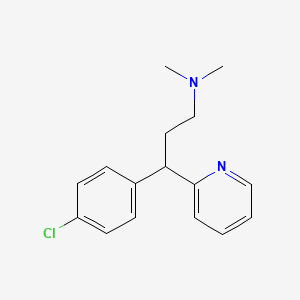Attribution Statement: LactMed is a registered trademark of the U.S. Department of Health and Human Services.
NCBI Bookshelf. A service of the National Library of Medicine, National Institutes of Health.
Drugs and Lactation Database (LactMed®) [Internet]. Bethesda (MD): National Institute of Child Health and Human Development; 2006-.
CASRN: 132-22-9

Drug Levels and Effects
Summary of Use during Lactation
Small (2 to 4 mg), occasional doses of chlorpheniramine are acceptable during breastfeeding. Larger doses or more prolonged use might cause effects in the infant or decrease the milk supply, particularly in combination with a sympathomimetic such as pseudoephedrine or before lactation is well established. Single bedtime doses after the last feeding of the day may be adequate for many women and will minimize any effects of the drug. The nonsedating antihistamines are preferred alternatives, though.
Drug Levels
Maternal Levels. Relevant published information was not found as of the revision date.
Infant Levels. Relevant published information was not found as of the revision date.
Effects in Breastfed Infants
In one telephone follow-up study, mothers reported irritability and colicky symptoms 10% of infants exposed to various antihistamines and drowsiness was reported in 1.6% of infants. None of the reactions required medical attention. In this study, no side effects were reported among 5 infants exposed to chlorpheniramine in breastmilk.[1]
Effects on Lactation and Breastmilk
Dexchlorpheniramine in relatively high doses given by injection can decrease basal serum prolactin in nonlactating women and in early postpartum women.[2,3] However, suckling-induced prolactin secretion is not affected by dexchlorpheniramine pretreatment of postpartum mothers.[2] Whether lower oral doses of chlorpheniramine have the same effect on serum prolactin or whether the effects on prolactin have any consequences on breastfeeding success have not been studied.
Alternate Drugs to Consider
References
- 1.
- Ito S, Blajchman A, Stephenson M, et al. Prospective follow-up of adverse reactions in breast-fed infants exposed to maternal medication. Am J Obstet Gynecol. 1993;168:1393–9. [PubMed: 8498418]
- 2.
- Messinis IE, Souvatzoglou A, Fais N, et al. Histamine H1 receptor participation in the control of prolactin secretion in postpartum. J Endocrinol Invest. 1985;8:143–6. [PubMed: 3928731]
- 3.
- Pontiroli AE, De Castro e Silva E, Mazzoleni F, et al. The effect of histamine and H1 and H2 receptors on prolactin and luteinizing hormone release in humans: Sex differences and the role of stress. J Clin Endocrinol Metab. 1981;52:924–8. [PubMed: 7228996]
Substance Identification
Substance Name
Chlorpheniramine
CAS Registry Number
132-22-9
Drug Class
Breast Feeding
Lactation
Antihistamines
Disclaimer: Information presented in this database is not meant as a substitute for professional judgment. You should consult your healthcare provider for breastfeeding advice related to your particular situation. The U.S. government does not warrant or assume any liability or responsibility for the accuracy or completeness of the information on this Site.
- User and Medical Advice Disclaimer
- Drugs and Lactation Database (LactMed) - Record Format
- LactMed - Database Creation and Peer Review Process
- Fact Sheet. Drugs and Lactation Database (LactMed)
- Drugs and Lactation Database (LactMed) - Glossary
- LactMed Selected References
- Drugs and Lactation Database (LactMed) - About Dietary Supplements
- Breastfeeding Links
- PubChem SubstanceRelated PubChem Substances
- PubMedLinks to PubMed
- Review Dexchlorpheniramine.[Drugs and Lactation Database (...]Review Dexchlorpheniramine.. Drugs and Lactation Database (LactMed®). 2006
- Review Carbinoxamine.[Drugs and Lactation Database (...]Review Carbinoxamine.. Drugs and Lactation Database (LactMed®). 2006
- Review Tripelennamine.[Drugs and Lactation Database (...]Review Tripelennamine.. Drugs and Lactation Database (LactMed®). 2006
- Review Pyrilamine.[Drugs and Lactation Database (...]Review Pyrilamine.. Drugs and Lactation Database (LactMed®). 2006
- Review Triprolidine.[Drugs and Lactation Database (...]Review Triprolidine.. Drugs and Lactation Database (LactMed®). 2006
- Chlorpheniramine - Drugs and Lactation Database (LactMed®)Chlorpheniramine - Drugs and Lactation Database (LactMed®)
- PMC Links for GEO Profiles (Select 79492305) (38)PMC
- txid2285449[Organism:noexp] (1)Identical Protein Groups
- hypothetical protein R2TS_12390 [Enterobacter asburiae]hypothetical protein R2TS_12390 [Enterobacter asburiae]gi|1995290630|dbj|BCT18067.1|Protein
Your browsing activity is empty.
Activity recording is turned off.
See more...
